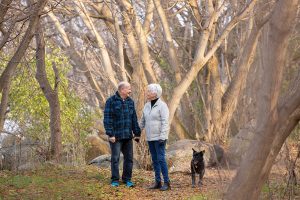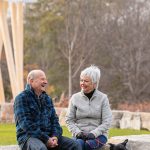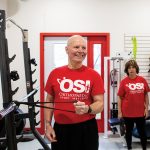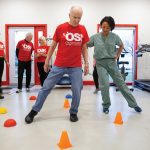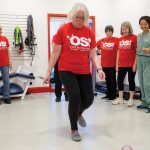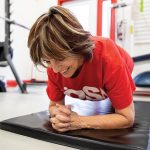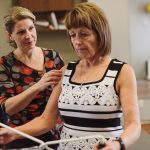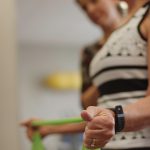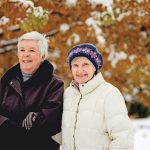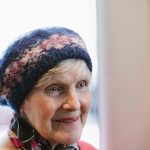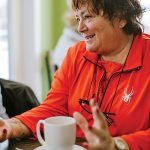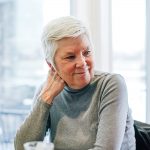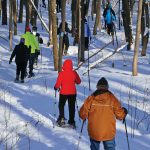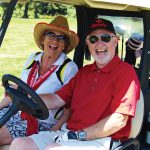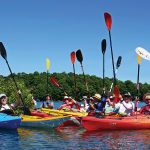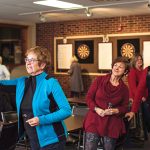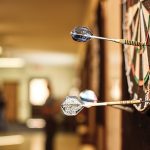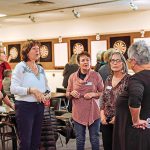The 5 pillars to successful aging
by Judy Ross
photos by Derek Trask
Simply put, Southern Georgian Bay is made for seniors. But not your grandparents’ brand of seniors; our seniors are active, engaged and energetic, perhaps more so than anywhere else in Canada.
From hiking and skiing along the Niagara Escarpment to swimming or kayaking in Georgian Bay, or biking and walking along the endless trails and roads that wind their way through breathtaking scenery, the outdoor offerings in our area are too numerous to list. Take the experience indoors to include absorbing the local art scene, attending local theatre, or taking part in lifelong learning seminars, and you’ll find there’s not enough time to do it all.
In order to enjoy the “golden years,” you have to be able to participate; not just physically, but mentally, socially and financially as well. Through the exploration of the pillars of aging (health, fitness, financial security, social wellbeing and a sense of purpose) we can gain a critical understanding about how to plan for a future of aging gracefully. Taking action on these plans liberates our minds, bodies and souls to live life to its greatest potential no matter what our age.
Catherine Randall, 75, and her husband Robin, 77, have reinvented their life a few times in the 60 years they’ve known one another. They followed a typical upper-class path while raising three children in Oakville. Robin worked on Bay Street and Catherine had a part-time job organizing high-end tours of art galleries and gardens around the world. When their kids moved out and Robin’s career on Bay Street came to an end, they looked at their life in Oakville and compared it to the life they had been living on weekends, at their second home just outside of Creemore.
The Randalls had downsized in Oakville and were living in a smaller home, with a larger custom home up north. It was time to make a change. However, Catherine had a busy social itinerary in addition to the demands of her small travel business, and was teaching yoga in Oakville, making her a little reluctant to move to Southern Georgian Bay full-time.
“Moving up here was a bit of a wrench for me,” admits Catherine. “But it turned out to be the best thing that ever happened; I really jumped into it.”
She began teaching yoga in Collingwood, Stayner and Creemore, became a business partner in the Creemore bookstore, Curiosity House, and remained socially and physically active through the Creemore Tennis Club.
Catherine became friends with people in their 40s alongside those approaching 100. “There’s such a diverse community in this area. In Oakville, all my friends were my age and we did the same things,” she says.
For Robin, the move meant opening a small investment management office in downtown Creemore, where he continued to work for many years.
As the couple prepared to move into their 70s, it was time to reinvent themselves again. They had long since sold their original country home and had built subsequent homes in the Creemore area, but decided it was time to downsize again. They now call a small cottage, in the heart of Collingwood, home. They have given up their expensive downhill ski membership at a private club in favour of Nordic skiing and have said goodbye to their costly golf membership (they now prioritize a month-long golf vacation with friends in South Carolina.) Freeing up this extra capital allows the Randalls to continue to do all the things they enjoy with family and friends, including an annual cottage rental where the family gathers for a couple of weeks each summer.
With a backpack on, Catherine rides or walks everywhere and has little use for a car. She teaches yoga three times a week, volunteers for the Blue Mountain Foundation for the Arts and works in a local art gallery once a week. She takes French classes in Dunedin, and they both play tennis, attend Probus events and go to Cinema Club once a week.
“My wife is so incredible because she’s always adding new learning opportunities,” says Robin. “There’s not enough to keep Cathy busy; she keeps finding things to add meaning to her life.”
Robin has a large garden where he grows cucumbers, beans, tomatoes and an impressive lettuce crop. He recently taught himself to build a deck and pergola so they can enjoy the garden while eating outside. And he continues to day trade by managing a small personal portfolio.
“Mentally, I’m challenged if I’m trading every day,” he says.
The Randalls epitomize aging gracefully. They are socially, physically and mentally active, and become more so as they age. They find joy in their family and in each other, and still have youthful amounts of energy, which allows them to participate to the fullest. Financially they have made sacrifices and commitments to ensure their retirement years can be enjoyed rather than endured.
“We complement each other,” says Robin. “People who are aging gracefully have to be really integrated as they move forward. They have to mesh with each other intellectually and physically.
I think we would be in the top 10 per cent as far as moving forward, staying young, fit and intellectually stimulated. That’s why we’ve been together for 60 years.”
The Randalls are grateful for what they have and want to pass it on.
“I try to be mindful, present and to smile at someone every day,” says Catherine. “I’m still curious, still investigating and learning and discovering, while helping a lot of people. It’s about contributing to the community and to the world in a positive way; it’s more about giving than receiving.”
The Randalls see not just aging, but living, as a holistic endeavour. Keeping ourselves engaged on all levels – physically, mentally, socially and spiritually – is integral to overall wellbeing.
HEALTH
Doctor Olivia Cheng couldn’t agree more. In September 2017, Dr. Cheng, an orthopedic surgeon recently appointed as chief of surgery at Collingwood General & Marine Hospital, began a program she calls the Peer Health Initiative (PHI). Since the PHI began, Cheng has reached over 150 participants, ranging in age from 65 to 85. Participants not only complete a four-week program, but many return to the program as mentors.
Cheng built the PHI around recommendations from The Canadian Medical Association and Public Health Agency of Canada for Healthy Aging. The PHI focuses on nutrition, exercise, chronic disease management, injury prevention, mental health, community engagement and continued learning. What makes the program stand out is that it addresses each of these areas in one accessible package, with a focus on prevention.
“Preventative health programs that currently exist usually focus on a limited number of determinants of health,” says Cheng. “Although these individual programs are excellent in the area of their focus, their benefits are limited due to the fact that they function in silos. There is not one place where they can go; this is why we started designing this program.”
Each free, 75-minute class runs once a week and follows the same outline. Classes begin with group warm-up, balance training and assessment, the introduction of two new exercises, a presentation on nutrition and a wrap-up with stress management techniques, often including meditation. By meeting once a week, The PHI also combats social isolation, which can be a huge problem for seniors and can spin off into all sorts of ailments, says Cheng. Isolation can come from moving to a new area, being recently widowed, the loss of friends, or the fear of injury, all very real scenarios for an aging population.
“What I like best is the structure. I know it’s coming,” says Jim O’Brien, 85, a program graduate who is now part of the mentor program. “The problem is often motivating yourself to keep at it, and that’s where the structure is helpful,” he says of attending the program regularly and being accountable to his peers.
With the PHI’s focus on prevention, Cheng could be putting herself out of business as a surgeon, and that would be fine by her.
“Our healthcare system is focused on disease, not prevention. It’s very expensive, but we don’t see it; our healthcare system is bankrupt,” says Cheng. “Eighty to 85 per cent of people who come to see me [for surgery] could avoid surgery by changing their lifestyle.”
Participants of PHI learn by moving says Cheng who shows off the gym where classes take place, in her Ontario Street complex in Collingwood.
“We play hopscotch, for example, because it works on balance, strength and coordination. It’s amazing to see how everyone improves with time,” she says. Participants go home with homework, new exercises to integrate into their daily routine, a food journal where they log daily meals and snacks, and they also keep a gratitude journal.
Queenie Rich, 73, is a graduate, a mentor and one of the PHI’s loudest cheerleaders. Rich fell and broke her hip skiing years ago and admits she wakes up sore most days. “But now I don’t focus on how sore my neck or my hips are; I am thankful that I am here and that I’m up,” she says.
Underlying everything the PHI has to offer is continued learning. “We stimulate learning as a fight against dementia and Alzheimer’s,” says Cheng.
Cheng provides power points for weekly talks, but the mentors are the ones who present, often doing extra research to augment their presentations on topics like sugars, proteins and carbohydrates. “We come back to teach, share and support,” says Rich of the mentor program.
Cheng emphasizes that everyone, no matter their age, needs to be a navigator of their own health. The mentor program brings this home.
“I ended up doing a bunch of research and found out why a certain exercise was important,” says Rich of a presentation she gave to new participants. “People did their homework and took notes during class. It’s amazing how each one of us was stimulated.”
FITNESS
Experts agree that physical activity can play a major role in the management of chronic disease and improve quality of life, yet nearly half of Canadian adults are not physically active enough to benefit their health and wellbeing. That number is likely lower in Southern Georgian Bay given our active lifestyle, but since physical fitness becomes more challenging as we age, even those of us who regularly engage in physical activity may not be doing enough to keep overall fitness levels high enough to prevent injuries and other ailments.
Julie Moss-Kujala, a physiotherapist at Lifemark Collingwood Sports Medicine and Rehabilitation Centre, believes education is fundamental to aging gracefully. Maintaining flexibility, balance and muscle mass are all reasons general maintenance becomes more important as we age, says Moss-Kujala, but we can’t take a one-size-fits-all approach and we can no longer take the shortcuts we did when we were younger (yes, stretching before and after exercise is a must).
“There is a lot of education that goes into how to do this,” she says. “It’s really important for people to have a diagnosis and know what’s going on with their body.” For example, she points out that walking, although considered a lower impact activity, might still cause too much impact for some, whereas biking could be a better solution. Not all forms of yoga work miracles; some styles may be too aggressive and modified forms like chair yoga might be more appropriate. It is important to find something that works for your body and that you enjoy, says Moss-Kujala.
“Enjoyment is where success lies.”
Moss-Kujala has been a practitioner in the area for 20 years, working with an aging and active population. “Because of where we live the majority of my patient base is over 50 and are people who are motivated and active but dealing with things that come up as we age,” she notes.
She sees challenges with osteoarthritis, tendonitis, a break-down of tissue, and general aches and pains related to certain repetitive activities. She also works with post-operation rehabilitation and the reality that recovery times become much longer as we age. “Problems arise from the natural aging process,” she says. “Each decade rolls into a new list of ailments.”
Unfortunately, but realistically, the list of age-related challenges increases as we get older. “Our hormone levels and tissue resilience change as we age, which can increase the risk of injury and cause degenerative changes in our tissues,” says Moss-Kujala. “This can also make it harder to maintain our muscle mass and strength.”
She admits that even as she herself ages, she has to invest more time into her general strength and flexibility in order to help prevent or manage injuries. She also points out that adequate rest, proper sleep, nutrition and hydration play an increasingly important role as we age.
But, she adds, it is important to remember that certain things don’t change with age. “Setting goals and always aiming to improve your physical health are not something that should diminish with age. Set realistic goals with your healthcare practitioner. It’s never too late to start, but you need guidance for safety.”
FINANCIAL SECURITY
Financially preparing for retirement can be as important as maintaining good health and fitness, and many argue that a stable and secure financial plan actually improves overall wellness.
Nancy Griffin, an associate consultant and certified financial planner with the IG Private Wealth Management, says health and wealth are interconnected. Griffin has been running workshops called “Women, Worth and Wellness” for years in Toronto and is now introducing them to Southern Georgian Bay. “It’s about health and wealth, net worth and self-worth,” she says. “Net worth enhances our self-worth; you feel good about yourself because you’ve done things right.”
Her program targets baby boomer women and their daughters. “Women’s life expectancy is greater than men’s and more often than not women end up with wealth to direct,” she explains.
Wealth management is increasingly focused on the family unit. Children are the ones most likely to inherit their parents’ wealth and they need to know what is involved.
Neal Owen, founder and president of BlueRock Wealth Management Inc., considers open and honest family meetings between seniors and their beneficiaries as paramount.
“The fastest-growing part of litigation is estates,” he says. “People need to know what they are getting and why. It limits a lot of litigation and allows siblings to better understand their parents’ mindset and ask questions.”
This open communication is necessary, yet it’s a foreign and daunting prospect to many, says Owen. For this reason, his company offers several seminars throughout the year, specifically aimed at coaching and preparing families for these crucial conversations.
“It’s the biggest and best thing seniors can do,” he says of opening the dialogue. “And it by no means requires changing wills to what the kids want.”
Financial conversations are often difficult, not just with family members but also with ourselves. We all hope to live to 95 and have enough money to get us there, but there is no guarantee.
“Even if you’re 22, you need a will; no one wants to talk about it, but it can happen,” notes Griffin. “When people turn 50 they start to think about aging and its consequences. In your 60s you think about doing something about getting older and getting organized. In our 60s and 70s it is important to think about downsizing and consolidating. By 70 all your affairs should be in order and you should appreciate your mortality by putting a comprehensive plan in place.”
One of the biggest financial concerns seniors have, adds Owen, is outliving their portfolio, but with the right plan this can be avoided. “You have to build a portfolio that absorbs the ups and downs,” he says. “You need a balanced portfolio that allows growth and will exceed inflation.”
Though none of us have a crystal ball, it is important to plan for life events such as kids getting married, a spouse getting sick, grandchildren or crucial home care before they actually happen.
“All of these things have an impact,” says Owen. “You have to make sure your financial plan can respond to these life events; 99 per cent of people have not planned and the sooner you do, the better.”
To place yourself among the one per cent that actually does plan, Owen suggests adhering to what has been coined the ‘Safe Withdrawal Rate.’ It’s a concept developed by academics, not financial advisors, and it has been widely accepted as the rule of thumb for retirement planning.
“You should not withdraw more than four per cent of your portfolio every year when you start retirement,” explains Owen. “There is a good chance you will outlive your money if you withdraw more to maintain your lifestyle.”
Life expectancy continues to increase, and many people today are living 30 years past retirement (a drastic increase from the decade our parents and grandparents lived post retirement), so preparation is key to ensuring that your money lasts as long as you do. In order to stay within the Safe Withdrawal Rate, Owen’s best advice is, no matter what your age, live within your means.
On the other end of the financial spectrum are seniors with portfolios that well exceed their need. “Often there is more wealth than can be used by themselves and their children, so we look at philanthropic ideas,” says Griffin of the work she does with some families.
She suggests planning for a family foundation, which not only has tax benefits but also offers an opportunity to gather as a family and discuss how to give back, essentially leaving a family legacy through a foundation.
“Its way more than investing; it’s more like how to get the best return on your whole life.”
PURPOSE
Leaving a financial legacy can have a huge impact on the future, but not everyone has the resources to donate large sums of money to the many worthwhile causes in need of a helping hand.
Volunteering is a way to give of your time, a commodity most people have more of as they age.
Volunteering not only offers critical help to individuals, causes and the community, but the benefits of volunteering can help the volunteer as well. Volunteering has been shown to reduce stress, fight depression, keep volunteers mentally stimulated, and it provides a sense of purpose.
Patty Federer believes volunteering in your community can do a lot to address the various pillars of aging gracefully. “Being a volunteer is good for you,” she says. “Studies show you live 10 years longer and have a better quality of life – physically, emotionally and financially – when you volunteer.”
Federer retired from working for the County of Simcoe five years ago, but is enjoying her “second career” coordinating volunteers for Home for Life, a not-for-profit operated by Community Connection in partnership with the South Georgian Bay Community Health Link.
“I came back to keep my brain engaged,” she says of returning to work part-time. “The brain muscle atrophies if not in use.”
Home for Life connects trained volunteers with aging clients, usually isolated seniors, in Southern Georgian Bay, helping them remain independent and confident in their home for as long as possible. “Clients are referred through medical professionals,” explains Federer. “They have been impacted negatively by social isolation.”
Currently Home for Life has 120 clients but only 71 volunteers. Another 50 are needed, 30 of those in Wasaga Beach. Volunteers must apply and be screened, after which their interests and personality traits are matched with clients. The time commitment for volunteers is flexible (usually one or two hours a week) and volunteers have a say in where they are going and who they are working with. “Our volunteers have to feel as good about the arrangement as the client,” says Federer. “There is an emotional piece; it has to have meaning to you, it can’t be a chore.”
She speaks from experience. Federer’s resumé includes volunteering for the Special Olympics for more than 20 years, endless volunteer hours spent with Alpine ski teams, and 25 years with the PGA Canadian Open.
“I’m benefitting from being involved. It’s keeping me healthy,” she says. “At the end of the day it feels like what I’m doing has meaning and matters.”
Ninety percent of what Federer facilitates through Home for Life is what she calls “friendly visiting.” “Volunteers may visit and play chess, have tea or just spend time together,” she explains.
Or it might mean going for a drive, out for coffee or shopping. Other areas of need include respite care where the spouse is the primary caregiver; assistance with specific forms of exercise like a visit to the pool; grocery shopping; transportation to medical appointments; dog walking; or seasonal yard work.
One area of expertise that is greatly needed and appreciated is in the realm of computer help and support. Federer organizes a monthly Seniors Computer Learning Café, which offers two hours of free computer assistance to anyone of any age. And if a client can’t physically get to a meeting, she organizes tech-savvy volunteers for home visits.
Although volunteers are usually in their 50s and 60s, Home for Life does have volunteers in their 80s who are often older than the people they are working with. The program also attracts some younger adults.
“We have one volunteer who, every Saturday, grocery shops with her two young children. She picks up her senior on the way, who has become an adopted grandma,” says Federer. “They shop, put groceries away and have lunch together.”
There are so many ways to help and the benefits go far beyond practical need. “It’s kind of magical what goes on,” she says of the relationships she has witnessed, some of which have lasted years.
SOCIAL CONNECTION
One of the undisputed benefits of volunteering is the social aspect. Staying active socially not only keeps the dangers of isolation at bay, but fills us up emotionally, with far-reaching benefits to overall health and wellbeing.
Like volunteering, social clubs offer an opportunity for seniors to stay connected. Clubs like Probus have taken off globally in the past couple of decades, and Southern Georgian Bay has more clubs than anywhere else in Canada, with 17 Probus clubs in our area alone. The largest Probus Club in Canada, with 600 active members, meets monthly in Thornbury, and the Probus Club of Collingwood started in 1987, making it the fourth-oldest club in Canada. “I believe in what Probus stands for,” says Bob MacNair, director of Probus Ontario District 7, which encompasses 29 clubs and 3,600 members. “I just get so excited about it. It is an opportunity to engage in social acts, meet people and learn.”
Probus (which stands for Professional Business) meets monthly, without obligations, meaning there is no fundraising or volunteering required for membership. It is non-political, non-religious and non-profit. “It gives people in their retirement years activities, social connections and learning opportunities,” says MacNair. “It opens up so many avenues with no obligations.”
No two Probus clubs are the same. Each organizes its own roster of speakers and plans its own social activities. Each club determines its own yearly membership fee – usually around $30 to $50 – and how many months of the year it will operate (some shut down over the summer). Member age varies, but you must be retired or semi-retired to join any Probus club.
MacNair belongs to three clubs, as each one offers different opportunities. Within each club, smaller interest groups form for people who share hobbies like fishing, travel or computers, or to organize monthly bike or Nordic ski outings. “It is all up to the members what they want to see happen and who they meet within their club,” says MacNair, who moved to Collingwood less than 10 years ago and thanks Probus for helping him integrate into a whole new community.
“I can personally go up to over 300 people and address them by name now,” he says. “Fellowship develops friendship and special interests.”
The demand for Probus club membership is so great that there are waiting lists for all of the current clubs in our area. “We don’t want waitlists, we want active members,” says MacNair.
“It’s time to create another club.”
Southern Georgian Bay continues to grow and develop as a retirement haven for active seniors. In most cases those who choose to retire here start out at a much younger age skiing the hills of the Escarpment, playing on the shores of the Bay and making social connections. We all want to enjoy those same activities as we get older, and in order to do so we have to prepare physically, emotionally and financially.
Facing our own mortality as we age is often difficult, but rather than seeing it as fatalistic, experts on aging see it as empowering. Embracing age and honouring our mortality help maintain the highest possible quality of life through all ages and stages, opening space to be thankful for each day we have on this planet and allowing us to plan for whatever the future holds. ❧
Related Story: CARP, the voice for mature Canadians. Read more here







